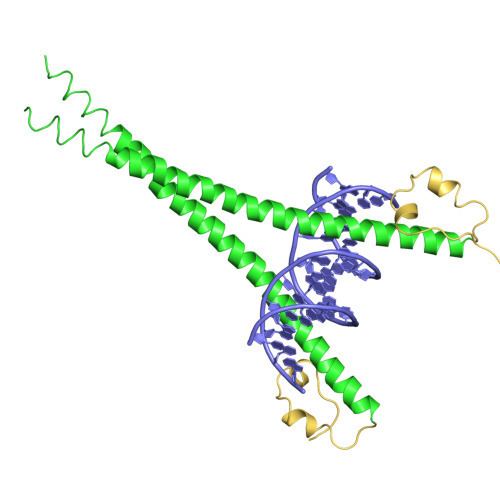Entrez 4097 | Ensembl ENSG00000197063 | |
 | ||
External IDs MGI: 96911 HomoloGene: 81816 GeneCards: MAFG | ||
Transcription factor MafG is a bZip Maf transcription factor protein that in humans is encoded by the MAFG gene.
Contents
MafG is one of the small Maf proteins, which are basic region and basic leucine zipper (bZIP)-type transcription factors. The HUGO Gene Nomenclature Committee-approved gene name of MAFG is “v-maf avian musculoaponeurotic fibrosarcoma oncogene homolog G”.
Discovery
MafG was first cloned and identified in chicken in 1995 as a new member of the small Maf (sMaf) genes. MAFG has been identified in many vertebrates, including humans. There are three functionally redundant sMaf proteins in vertebrates, MafF, MafG, and MafK.
Structure
MafG has a bZIP structure that consists of a basic region for DNA binding and a leucine zipper structure for dimer formation. Similar to other sMafs, MafG lacks any canonical transcriptional activation domains.
Expression
MAFG is broadly but differentially expressed in various tissues. MAFG expression was detected in all 16 tissues examined by the human BodyMap Project, but relatively abundant in lung, lymph node, skeletal muscle and thyroid tissues. MafG gene expression is induced by oxidative stresses, such as hydrogen peroxide and electrophilic compounds. Mouse Mafg gene is induced by Nrf2-sMaf heterodimers through an antioxidant response element (ARE) at the promoter proximal region. In response to bile acids, mouse Mafg gene is induced by the nuclear receptor, FXR (Farnesoid X receptor).
Function
Because of sequence similarity, no functional differences have been observed among the sMafs in terms of their bZIP structures. sMafs form homodimers by themselves and heterodimers with other specific bZIP transcription factors, such as CNC (cap 'n' collar) proteins [p45 NF-E2 (NFE2), Nrf1 (NFE2L1), Nrf2 (NFE2L2), and Nrf3 (NFE2L3)] and Bach proteins (BACH1 and BACH2).
sMaf homodimers bind to a palindromic DNA sequence called the Maf recognition element (MARE: TGCTGACTCAGCA) and its related sequences. Structural analyses have demonstrated that the basic region of a Maf factor recognizes the flanking GC sequences. By contrast, CNC-sMaf or Bach-sMaf heterodimers preferentially bind to DNA sequences (RTGA(C/G)NNNGC: R=A or G) that are slightly different from MARE. The latter DNA sequences have been recognized as antioxidant/electrophile response elements or NF-E2-binding motifs to which Nrf2-sMaf heterodimers and p45 NF-E2-sMaf heterodimer bind, respectively. It has been proposed that the latter sequences should be classified as CNC-sMaf-binding elements (CsMBEs).
It has also been reported that sMafs form heterodimers with other bZIP transcription factors, such as c-Jun and c-Fos.
Target genes
sMafs regulate different target genes depending on their partners. For instance, the p45-NF-E2-sMaf heterodimer regulate genes responsible for platelet production. Nrf2-sMaf heterodimer regulates a battery of cytoprotective genes, such as antioxidant/xenobiotic metabolizing enzyme genes. The Bach1-sMaf heterodimer regulates the heme oxygenase-1 gene. In particular, it has been reported that Bach1-MafG heterodimers participate in the hypermethylation of genes with CpG island promoters in certain types of cancers. The contribution of individual sMafs to the transcriptional regulation of their target genes has not yet been well examined.
Disease linkage
Loss of sMafs results in disease-like phenotypes as summarized in table below. Mice lacking MafG exhibit mild neuronal phenotype and mild thrombocytopenia. However, mice lacking Mafg and one allele of Mafk (Mafg−/−::Mafk+/−) exhibit more severe neuronal phenotypes, severe thrombocytopenia and cataracts. Mice lacking MafG and MafK (Mafg−/−::Mafk−/− ) die in the perinatal stage. Finally, mice lacking MafF, MafG and MafK are embryonic lethal. Embryonic fibroblasts that are derived from Maff−/−::Mafg−/−::Mafk−/− mice fail to activate Nrf2-dependent cytoprotective genes in response to stress.
In addition, accumulating evidence suggests that as partners of CNC and Bach proteins, sMafs are involved in the onset and progression of various human diseases, including neurodegeneration, arteriosclerosis and cancer.
